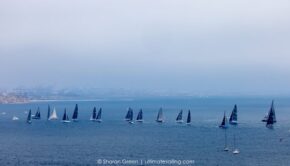In pursuit of the possibility of parity
Published on March 11th, 2019
While fair competition among dissimilar boats may seem like an oxymoron, this should not dissuade the pursuit of the possibility. But certain conditions always favor certain boats, and unless a rating system is suitably flexible to adjust for changing conditions, its ability to fairly handicap boat speed will suffer.
Woody Norwood explains what is being tested this season for the local racing in Beaufort, SC.
Our growing fleet of Marshall 18 Sanderling catboats races with the PHRF fleet, but at certain times of the year when we have a lot of light air conditions (under 8 knots), the 18-foot Sanderlings perform exceptionally well compared to the boats with heavier displacement and more wetted surface area due in part to keels (the Sanderling catboats are center-boarders).
Basically, in light conditions, the base handicaps don’t seem to apply, and the Sanderlings typically leave the lower handicap boats in their wake, with the effect that many of the heavier displacement boats effectively have given up PHRF racing… not a good development.
So, we are experimenting with a new “Light Air Handicap” formula that will be invoked for the first time in the Classic Boat Rally April 24-26 if, in the judgment of the PRO, the course of the race is going to be 8 knots or less.
Because the Marshall Sanderlings seem to be the fulcrum, performing equally well in light and heavy air conditions, we are using these boats as the pivot point, and, due to lack of wetted surface data, we are using the standard formula for Sail Area/Displacement upwind as the criterion for adjusting handicaps for “Light Air”.
Specifically, to the degree that SA/D differs from the Marshall Sanderlings, we will add or subtract handicap ratings times four.
For example, the SA/D for a Sanderling is 23.93 with a Base PHRF of 304, and the SA/D for a Marshall 22 is 19.67 with a base PHRF of 286. If we invoke the Light Air Handicap we would add 4 times the difference in SA/D and raise the Marshall 22 from 286 to 303, noting that in light conditions the 18-foot Marshall Sanderlings are about on par with the larger but heavier displacement (with inboards) Marshall 22s.
We are going to extend this to heavier displacement Cape Dory 28s. The latter have a PHRF of 229 around Beaufort. When we invoke the Light Air Handicaps, their SA/D raises their handicap to 269, and we don’t know if this adjustment is enough.
We think that in Light Air conditions we are moving in the right direction. Wetted surface might very well be a more accurate determinant for light air adjustments, but wetted surface measures are not readily available, so we use SA/D.
If there is interest, we will report the results not only in actual competitive results but, perhaps more importantly, the difference this seems to make in attitudes of those who have felt that PHRF racing is inherently unfair in light conditions.
I’ll say that the other change we have made is to recognize that some owners/skippers are life-long racers who maintain their boats in racing condition, while others are less experienced/skilled who are mainly cruisers but want to compete occasionally and maintain their boats for cruising. To address this, we have created two categories of participants, based on individual voluntary selection.
It’s not right, in my view, to have dedicated racers with vast experience competing with relative newcomers who are learning the ropes or who do not have the resources or racing focus to keep their boats and rigs in racing condition. We want newcomers to come out and participate and get the experience.
So in the Classic Boat Rally, we are allowing the participants to choose whether they are Racers or Cruisers. We will provide racing trophies in both categories, and I hope and believe that this will bring out folks who will potentially be among the next generation of sailing leaders.









 We’ll keep your information safe.
We’ll keep your information safe.